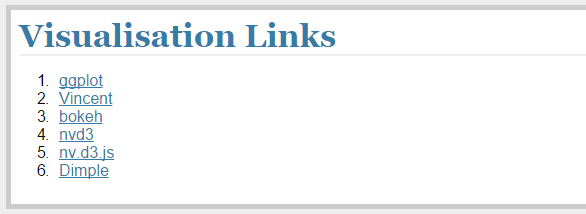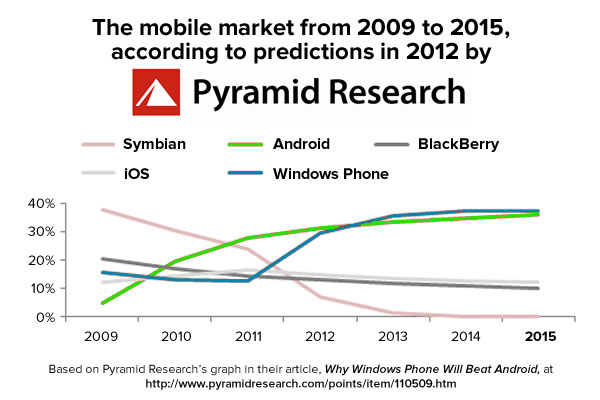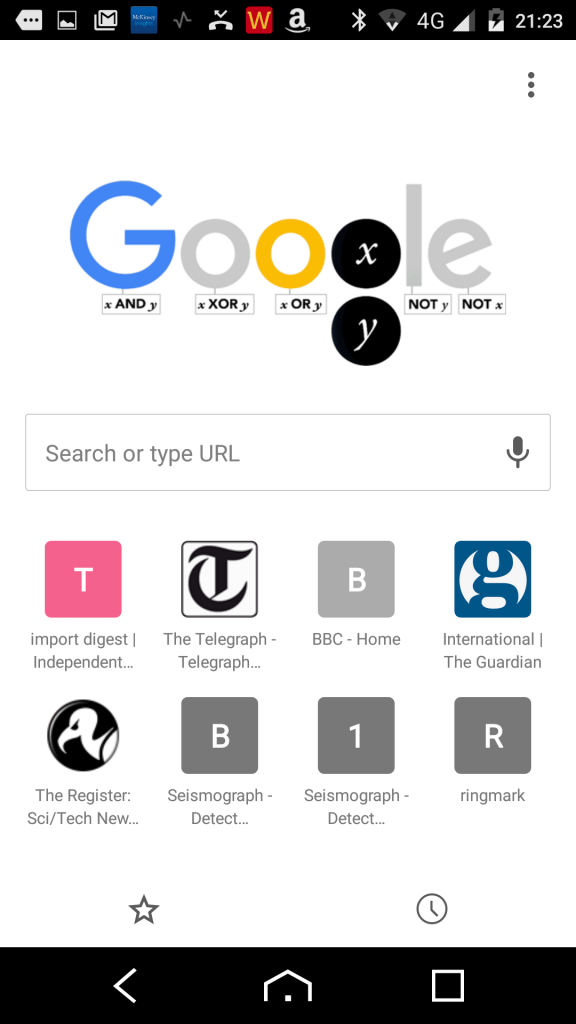Sections
Self-referential data visualisation VI: Double Docker
[avatar user=”malm” size=”small” align=”left” link=”file” /]
Over the last five weeks I’ve developed a simple Python-based data visualisation pipeline for my blog stats culminating in last week’s basic Flask app. This week, I will further evolve that app by reorganising the code and adding templates and styling. This improved version will then be hosted on the same Digital Ocean instance coexisting with, but isolated from, the first by means of a second Docker container.
Refactoring, templates and CSS
Our starting point last week was a single app.py using a utility file called blog6.py. In this week’s refactored web2 app, app.py has been modified to use Flask templates. In addition the old utility file has been split into two separate ones called mongolab.py and graphs.py which manage the mongolab.com cloud database handling and graph data creation respectively. The corresponding Flask templates reside in a new ‘templates‘ subdirectory and a simple CSS file, style.css, lives in a ‘static‘ subdirectory. Here’s an example of how the new app.py invokes a styled template which uses jinja2 markup in this case to create a Vincent graphic:
@app.route('/vincent/')
def vincent():
title = 'malm.teqy.net 2015 blog statistics using vincent'
jsondata = graphs.vincentVisualisationData(df,width,height,title)
return render_template('vincent.html',\
title=title, width=width, height=height, data=jsondata)
<!doctype html>
<title>{{ title }}</title>
<link rel=stylesheet type=text/css href="{{ url_for('static', filename='style.css') }}">
<script src="http://d3js.org/d3.v3.min.js" charset="utf-8"></script>
<script src="http://d3js.org/topojson.v1.min.js"></script>
<script src="http://d3js.org/d3.geo.projection.v0.min.js" charset="utf-8"></script>
<script src="http://trifacta.github.com/vega/vega.js"></script>
<div class=page>
<h1> {{ title }} </h1>
{% block body %}
<div id="vis"></div>
{% endblock %}
</div>
<script type="text/javascript">
// parse a spec and create a visualization view
function parse(spec) {
vg.parse.spec(spec, function(chart) { chart({el:"#vis"}).update(); });
}
parse({{ data|safe }});
</script>
The end result is structurally similar to last week’s example but more modular and consistently styled:
Double Docker
A second Docker container has been built and deployed onto same the Digital Ocean VM running last week’s container using the following commands:
$ docker build -t flaskapp2 . $ docker run -d -p=5001:5001 --name web2 flaskapp2
And now we have two Docker containers running separate Flask apps on the VM, the older one on port 5000 and the new one built this week on port 5001 verified with this Docker command:
$ docker ps CONTAINER ID IMAGE COMMAND CREATED STATUS PORTS NAMES f59f538c1e72 flaskapp2 "python /usr/src/flas" 6 seconds ago Up 4 seconds 0.0.0.0:5001->5001/tcp web2 676f987989ce flaskapp "python /usr/src/flas" 6 days ago Up 6 days 0.0.0.0:5000->5000/tcp web
You should also be able to browse the second container at http://labs.malm.co.uk:5001. To pull a copy of all the code for building both the web and web2 containers, run the following command:
$ hg clone https://bitbucket.org/malminhas/blog
There are several other directions that could be explored from here. One useful one would be to replace the cloud mongolab database with a local redis store. However, I’m going to park the extended data visualisation with Docker exercise here for now.
Mobile Devices and Platforms
- It’s 2015 already, the year when Windows Phone was supposed to be in it’s third year of market leadership if you recall the absurd prediction made by Pyramid Research in 2012:
- In fact the reality is that it is Apple not Microsoft that dominates mobile mindshare and, in fact, as Stratechery points out has an increasing stranglehold at the top end. This is reflected in ever more stellar earnings. Dismiss or ignore them at your peril:
Apple’s increasing monopoly on the high-end of the market is creating a virtuous cycle that ensures they will own the high-end indefinitely. From an app perspective, new and updated apps launch first on iOS, which means people who care buy iPhones, which means future new and updated apps launch first on iOS. From a component perspective, Apple is increasingly the only manufacturer that can even afford to buy the best components, and they have massive scale which ensures they get first dibs on what is new.
- And as if that weren’t enough, as pointed out before in the blog, they’re aiming to mass convert low end Android users too using their clever upgrade program with apparent success:
And Apple’s iPhone plans are clearly working. The company announced that 30% of iPhone sales last quarter come from Android switchers. It’s likely that many iPhone buyers were able to take advantage of various iPhone upgrade programs available from retailers – Apple’s program only launched last quarter as well – and score contract-free new iPhones for cheaper prices than they’d be otherwise used to.
- Meanwhile Android manufacturers remain under the cosh. HTC “has stopped issuing future guidance going forward on its financials” citing “uncertainty”. LG’s successes to date in 2015 were reversed in Q3 as “the firm’s mobile division lost $67.8 million in the last three months“. And this leaked internal slide reveals what passes for innovation at Samsung and all too many other OEMs it seems – tweaking Android until it looks like iOS:
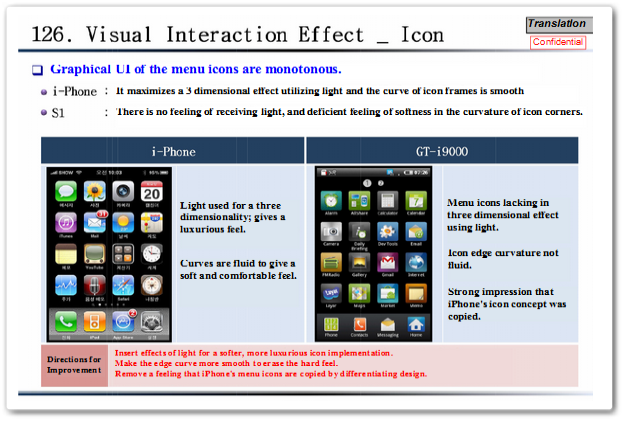
- The OnePlus X goes even further in iPhone envy. It’s “a 5-inch phone that feels like it should be $500, but costs only $249” which is also “a shameless tribute to the design of older iPhones“. The Verge took a closer look.
- Mozilla is launching a $1million Open Source support program.
- Innerexile have a “magical” instant repair screen protector for the iPhone6s that uses a “hydro-oleophobic coating”:
So what’s the secret sauce behind this new coating? Well, it’s dotted with microcapsules that contain an adhesive-like liquid, and when damaged, the liquid will fill the void so quickly that you probably won’t even realize you’ve just scratched your case or screen protector.
Google and Android
- News emerged that Google will be uniting Android and ChromeOS as a single cross-platform offering perhaps as soon as MWC next year:
“Combining the two operating systems means setting up Android to run on laptops and desktop computers, which would require big changes, as well as supporting the Google Play Store”
- Meanwhile Chrome for Android has a new eight tab view. Here it is on my phone together with a still image from the George Boole Google Doodle.
- Microsoft have released an Android launcher called Arrow. It’s nice and clean but pretty basic. It doesn’t seem to be possible right now to extend the number of screens available.
- Microsoft releasing an interesting Android feature. Whatever next? How about WSJ interviewing EU antitrust chief Margrethe Vestager on Google and other key cases:
people don’t think so much about the operating system on their phone. But those who produce phones or sell phones or develop applications, they are very preoccupied with the operating system.
Mobile Apps and Services
- Staying with Microsoft, they’ve also added polish to their mobile Outlook app suite offering built on the acquisition of Acompli last year and rebranding of its technology. That allowed Microsoft to bypass all the tribulation of building Outlook from scratch for rival platforms. By all accounts it’s been a spectacular success and vividly demonstrates why acquisition can often be a strategic game changer. Microsoft are expanding on their foothold by integrating further acquisitions including the Sunrise smart calendar. The screenshots below show Outlook on Android on the left and iOS on the right:
[Outlook] has almost 30 million users on smartphones and tablets, who use the app for 1.2 billion sessions a month, each 22 seconds long on average. Stats on mobile email market share are tough to come by, but that represents a huge jump from Acompli, which had fewer than 200,000 users before it morphed into Outlook. The company has continued with the strategy it started with the Acompli acquisition by buying the Sunrise smart calendar app and Wunderlist task manager.
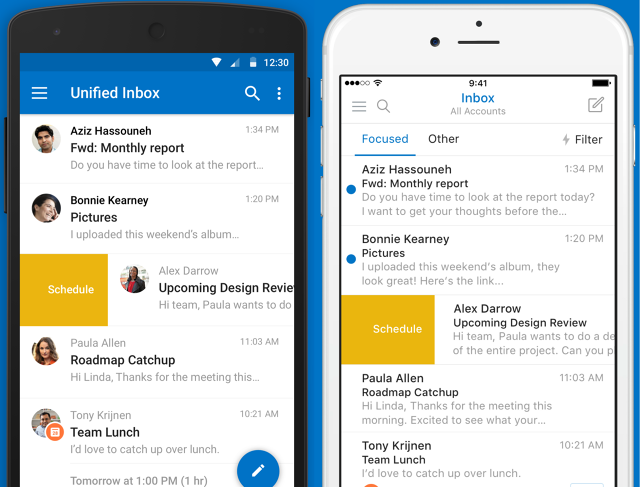
- Smart address book proposition FullContact is now available for Android.
“you can use the app to be notified when people change email address and other information, and update your records for them easily across all your connected address books”.
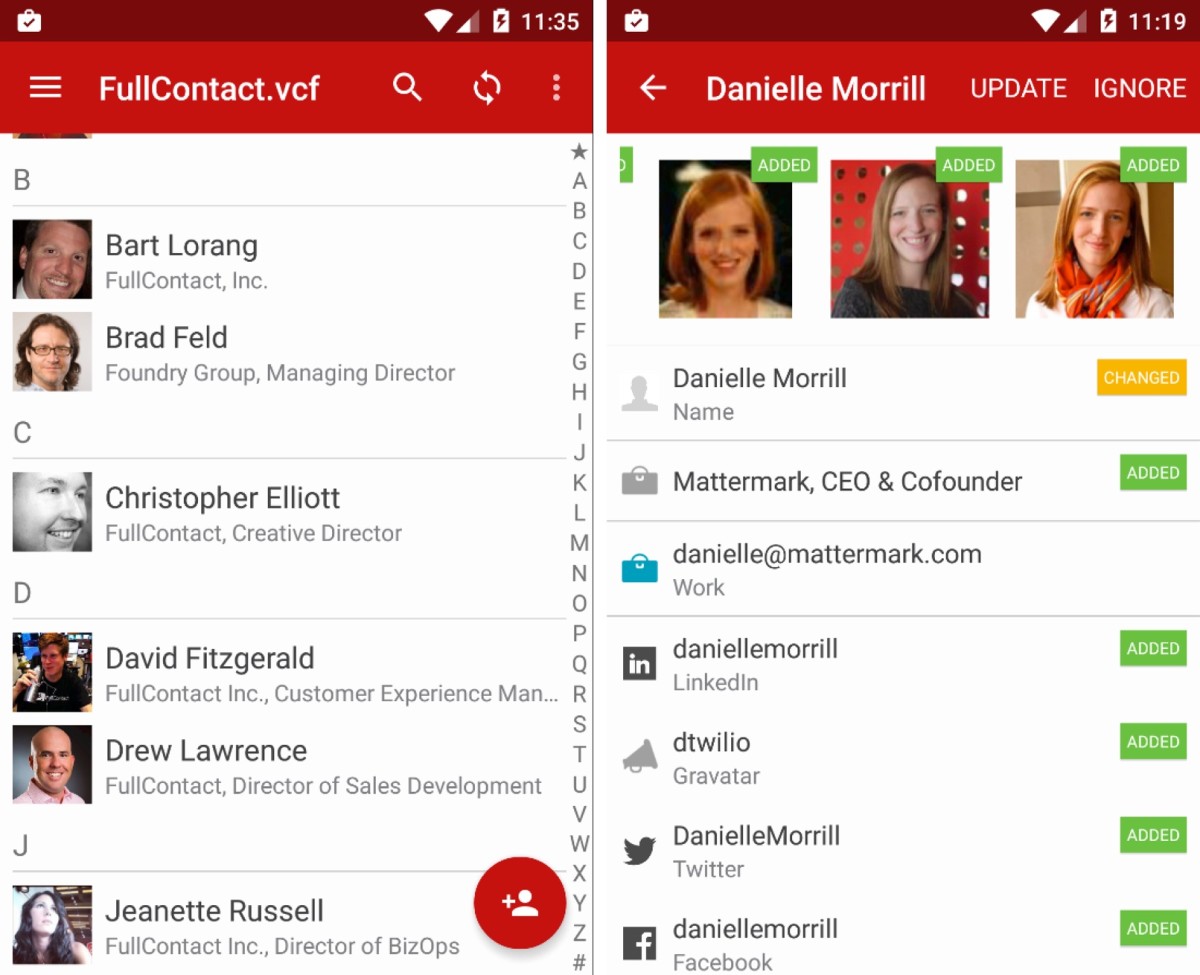
- TNW opinion piece from a TNW correspondent on why he dropped Dropbox “and you should too”. Dropbox, rather like Flipboard, is in danger of finding itself dangerously placed at the nexus of the colliding tectonic plates of the giant platform players:
As Apple, Microsoft and Google have invested in integrating their cloud storage neatly into their ecosystems, it’s gradually negated the need to use Dropbox at all, and made its pricing far less appealing.
- Bulk SMS gateway API vendor Nexmo will power KLM’s integration with WeChat. Which reminds me, I looked at it exactly a year ago. Out of curiosity I just re-ran my “hello world” SMS sender Python script and it still works. Props are due. To use this script you need to register with Nexmo and get an API_KEY and API_SECRET. SOURCE and DEST are phone numbers.
from nexmomessage import NexmoMessage
msg = {
'reqtype': 'json',
'api_key': API_KEY,
'api_secret': API_SECRET,
'from': SOURCE,
'to': DEST,
'text': 'Hello, world!'
}
print("Sending message:\n%s" % msg)
sms = NexmoMessage(msg)
sms.set_text_info(msg['text'])
response = sms.send_request()
print(response)
{u'message-count': u'1', u'messages': [{u'status': u'0', u'network': u'23415', u'remaining-balance': u'1.93960000', u'to': u'xxxxxxxxxx', u'message-price': u'0.03140000', u'message-
id': u'020000008665F94A'}]}
- This exhausting but highly insightful FirstRound post distills the collective wisdom of Kamo Asatryan on how to grow your mobile app user base. He is billed as “one of a small handful of people who have observed hundreds of mobile apps, thought deeply and scientifically about their mechanics, and determined what they could change to grow faster“:
In this exclusive interview, Asatryan not only provides the formulas he relies on to help mobile apps optimize their entire user funnel, but the counterintuitive lessons and mistakes he’s learned on the job. Anyone who works on a mobile app in any capacity has something to gain from this clear-cut look at what drives true, meaningful growth.
- Astrayan’s eight key takeaways:
- Don’t over-educate your users.
- Bust unexpected sources of friction.
- Find opportunities for positive reinforcement.
- Find and focus on your best referral channels.
- Make referrals a valuable win-win.
- Consider double-sided incentives.
- Don’t rely on standard social media sharing.
- Aim for steady growth.
Artificial Intelligence
- Apple may have hired NVIDIA’s director of AI but their notorious secrecy is proving counterproductive in its efforts to build internal artificial intelligence competence. The company has issued zero research papers in the area despite having a large number of scientists engaged on Siri et al which doesn’t sit well with Millenials:
The ability to continue publishing and otherwise maintain a presence in the scientific community is the most important factor for top students making career decisions,
- BrainPickings published a review of a book rambling through the varied views of leading thinkers on Artificial Intelligence and what it means to be human. It’s a bit of a mixed bag with a fair degree of that most human of traits, contradiction. This is from a much longer quote from Kevin Kelly in which he elaborates on the reality that “the kind of thinking done by today’s emerging AIs is not like human thinking” and what that means:
“AI could just as well stand for Alien Intelligence. We cannot be certain that we’ll contact extraterrestrial beings from one of the billion Earthlike planets in the sky in the next 200 years, but we can be almost 100 percent certain that we’ll have manufactured an alien intelligence by then. When we face those synthetic aliens, we’ll encounter the same benefits and challenges we expect from contact with ET. They’ll force us to reevaluate our roles, our beliefs, our goals, our identity.”
- Long and characteristically erudite post from David Wood (dw2) taking the long view on technological unemployment. It’s commonplace on these occasions to refer to the precedent of the Luddites but Wood makes a compelling case for “why it’s different this time“:
Yes, humans can retrain over time, to learn new skills, in readiness for new occupations when their former employment has been displaced by automation. However, the speed of improvement of the capabilities of automation will increasingly exceed that of humans. Coupled with the general purpose nature of these capabilities, it means that, conceivably, from some time around 2040, very few humans will be able to find paid work.
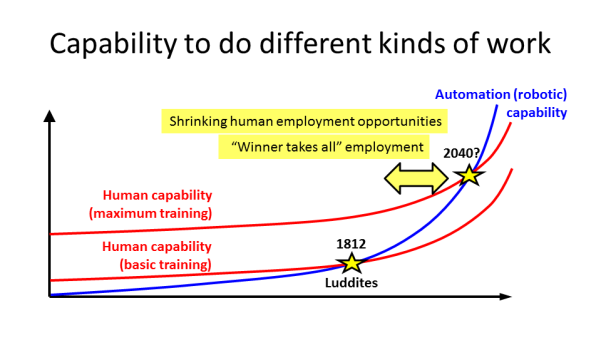
- Serving to underline dw2’s point, Tesla S users are reporting their new autopilot feature is “learning fast“.

The Internet of Things
- VisionMobile have published a paid-for report on the 2015 Wearables Landscape which is full of interesting stats like this:
Wearable developers are more likely than other IoT developers to be young (80% are under 35), female (9.7% vs 6.7%) and based in Asia (44%, almost as much as North America and Europe combined).
- HBR on what typical consumers would like from the Internet of Things today. Security is top of the list of potential use cases and yet ironically IoT security remains problematic with issues ranging from a lack of unified architecture for device security patch updates to missing controls for enforcing privacy of sensitive IoT user data at the backend.

- The security holes in IoT need to be dealt with if we are to avoid catastrophic consequences given the scale increase in attack surface represented by having the “internet on things“.
Security
- The Register took TalkTalk to task after their CEO’s comments about a “sequential attack” turned out to be more the work of Bobby Tables than “international cyber criminals”:
Getting confused between “sequential attack” and a SQL injection attack is an easy enough mistake to make for a firm outside the technology sector. But TalkTalk is a telco so customers are entitled to expect it to have a clearer grasp of standard infosec practices.
- The FT also weighed in suggesting TalkTalk only had themselves to blame following what appeared to be a lethal combination of slack security and an alarmingly loose disclosure without any apparent lockdown:
“Interest in TalkTalk as a possible target for hacking may have been piqued after one of the company’s customer service representatives tweeted information that indicated the company stored customer’s login credentials in an unencrypted format, sparking more than 2,400 responses on the social media site, according to Recorded Future. Discussions about TalkTalk’s unencrypted databases and at least 11 so-called cross-site scripting vulnerabilities took place on online forums used by hackers weeks before the actual attack on the company was announced.”
- Perhaps TalkTalk should take note of this advice from APMG that responsibility for cyber security “should start and stop at Board level”:
Boards must become fluent in the language of cyber security to improve the way their companies deal with threats. When it comes to cyber security, when does ignorance become negligence?
- Google’s slapdown of Symantec over its sloppy practices on certificate issuing created a bit of a stir. Arstechnica see it as part of a broader clean-up campaign against lax Certificate Authorities.
- The Telegraph are reporting that consumer-oriented peer to peer encrypted communication propositions may be banned under the Investigatory Powers Bill. If true, this would have a profound impact on the likes of Silent Circle.
Software Engineering
- Quora questioner asks “How does Google manage a single source code repository with 2 billion lines of source code” elicited an insightful response from a Googler who indexed it all. It’s an awe-inspiration toss up between 1 billion lines of C++ and 500 million lines of Python:
First of all, not all 2B lines of code were in one language. Maybe about 50% of the code was in C++, 25% in Java, and 25% in python and other random small languages like sawzall and protocol buffer declarations. (Maybe Go as well, nowadays)
- An awesome BSOD:
An awesome BSOD pic.twitter.com/nulfkoOELx
— Gi0 (@sitoig) October 8, 2015
- This TechCrunch perspective piece on why coding academies are “nonsense” makes for interesting reading. There are some valid points in amongst the abrasive commentary. The essential point being that coding day in, day out is not a career for everyone and is in any case exposes you to rapid skills obsolescence:
In 20+ years of professional coding, I’ve never seen someone go from novice to full-fledged programmer in a matter of weeks, yet that seems to be what coding academies are promising, alongside instant employment, a salary big enough to afford a Tesla and the ability to change lives.
Digital Enterprise
- HBR on Europe’s other crisis namely a digital recession fuelled by a “glaring and growing digital gap as Europeans watch the U.S. and China take the lead in tech innovation“. To rebound Europe needs to invest in innovation capacity and develop a more risk-tolerant culture. Or face being also-rans behind the BRICS MINT cohort.

Science
- NYT on how Greenland is “melting away”.
- The world’s largest offshore wind farm is to be built in the Irish Sea off the Cumbrian coast.
Startups
- You’ve heard of DevOps. This FirstRound post extols the virtues of Sales Ops. When done right they can make the difference between success and failure.
- Mark Suster takes a characteristically plain-speaking look at the state of VC approaching 2016. He sees it as a cool-down year citing valuation evidence from recent unicorn exits:
Work
- This must read post from Tim O’Reilly is part of his series on what he terms the WTF economy. In it he outlines why high freedom environments “where employees are given a great deal of discretion to “do the right thing” for customers, and where the company seeks to do the right thing for employees” represent the future of work. It may be the only element of the psychological contract we can hold onto as meaningful in a work environment increasingly tilting to a transactional vs. loyalty-led model:
“The employer-employee relationship is broken, and managers face a seemingly impossible dilemma: the old model of guaranteed long-term employment no longer works in a business environment defined by continuous change, but neither does a system in which every employee acts like a free agent. The solution? Stop thinking of employees as either family or as free agents. Think of them instead as allies.”
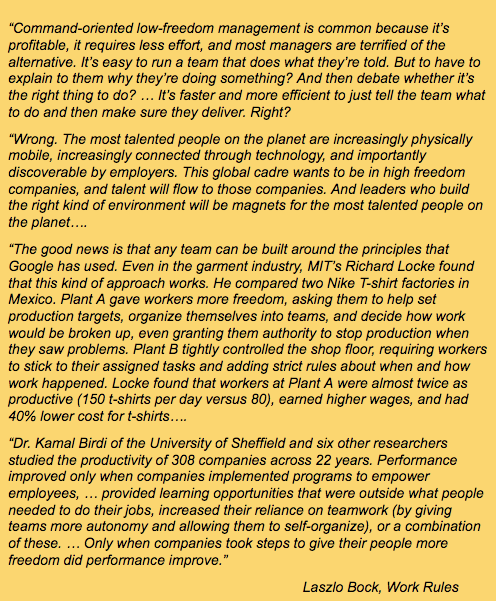
- Within that context of alliances, it ought to be a perfectly rational move to consider using contract staff to augment a permanent base. In fact it may even be essential to do so given that increasingly the best pros with the most up to date skills are only available through contract. And of course extensive use of ‘staff-on-demand’ is also a hallmark of Exponential Organisations along with autonomy which will be expanded upon below. Nevertheless it remains relatively common to encounter some corporate discomfort at the thought of relying on contractors on ‘loyalty’ and total cost grounds.
- The reality is that all too often companies are not very good at treating employees like people either as this HBR post points out. It underscores the importance of establishing a high freedom culture in the workplace:
There is little doubt that discretionary effort by people who are empowered to give their best produces not just better morale but also better products and services.
- Even Google with its famed working environment has to deploy the Performance Improvement Plan (PIP) playbook on occasion. In this dismissal detailed in a Quora response, the end came swiftly for a burnt-out engineer. Least he got a coffee out of it:
In the end they didn’t wait for PIP to run through and gave me a termination notice in another week. I returned my Google hardware and badge, and my manager walked me out of the building – all in 10 minutes or so. My Google employee account was revoked at the same time. We went to a nearby cafe with him, and he even paid for a drink though 🙂
Culture and Society
- In a week when the new James Bond film broke box-office records with even Snapchat jumping on the bandwagon, Quartz quoted real-life SIS agents who put a damper on proceedings:
If James Bond actually worked in MI6 today, he’d spend a large amount of time behind a desk doing paperwork and making sure everything was properly cleared and authorized.
- Spectre involves a shadowy global criminal network that exploits information networks to build a digital panopticon. Apparently even busy Bond villains manage full quorum face to face meetings. The capitalist villains and cronies at the heart of John Kay’s fluent 45-minute Google Talk on “Other People’s Money” are arguably equally shadowy and omnipotent. In his lecture, Kay covers the history and operation of the financial sector and the negative consequences of “financialisation” of the global economy over the last few decades. The title of his eponymous book comes from a 1914 classic that remains valid today:
The goose that lays golden eggs has been considered a most valuable possession. But even more profitable is the privilege of taking the golden eggs laid by somebody else’s goose. The investment bankers and their associates now enjoy that privilege. They control the people through the people’s own money
- TechInAsia on how smoking is “set to kill a third of young Chinese men“. Given that grim backdrop there seems a clear business opportunity for evangelising vaping there.
- Quartz outline evidence suggesting that dancing with friends is good for your health. Turns out Bez was onto something all along:
So the next time you find yourself at an awkward Christmas party or wedding dance floor, wondering whether or not to get up and groove, just do it.
